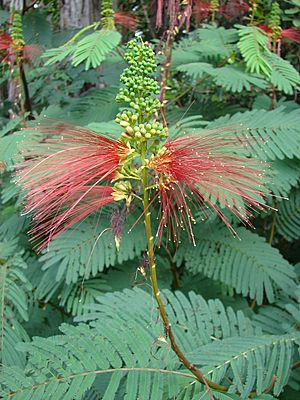Calliandra houstoniana facts for kids
Quick facts for kids Calliandra houstoniana |
|
|---|---|
 |
|
| Scientific classification | |
| Genus: |
Calliandra
|
| Species: |
houstoniana
|
| Synonyms | |
|
|
Calliandra houstoniana is a type of flowering plant that belongs to the Calliandra genus. It is part of the Fabaceae family, which is also known as the pea or legume family. This plant is known for its unique and often fluffy-looking flowers.
Contents
What is Calliandra houstoniana?
Calliandra houstoniana is a specific kind of plant within the Calliandra group. These plants are often shrubs or small trees. They are famous for their beautiful, brush-like flowers. These flowers usually have many long, colorful stamens. Stamens are the parts of a flower that produce pollen.
The Pea Family Connection
Being in the Fabaceae family means Calliandra houstoniana is related to many plants we know. This family includes peas, beans, and peanuts. Plants in this family often have special pods that hold their seeds. They also play a big role in nature. They help put nitrogen back into the soil. Nitrogen is a very important nutrient for plants to grow.
Where Does It Grow?
Plants like Calliandra houstoniana typically grow in warm, tropical, and subtropical areas. They prefer sunny spots and well-drained soil. You might find them in forests, along riverbanks, or in open fields. Their ability to grow in different places shows how adaptable they are.
Features of Calliandra Plants
Calliandra plants, including C. houstoniana, have several interesting features. Their leaves are often compound, meaning they are made up of many smaller leaflets. These leaflets can sometimes fold up at night or when it's very hot. This is a cool way for the plant to protect itself.
The Unique Flowers
The flowers are the most striking part of Calliandra plants. They look like colorful powder puffs or tiny fireworks. This is because of their many long, thin stamens. These stamens can be red, pink, white, or purple. They attract pollinators like hummingbirds and butterflies. These animals help the plant make new seeds.
Why Are They Important?
Calliandra plants are important for several reasons. They add beauty to their environments with their vibrant flowers. They also provide food and shelter for various animals. Some species are even used by people for wood or as ornamental plants in gardens. Their role in the ecosystem is vital for biodiversity.
Images for kids
See also
In Spanish: Cabeza de ángel para niños



